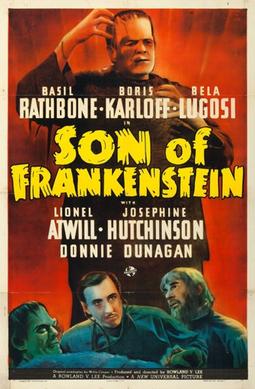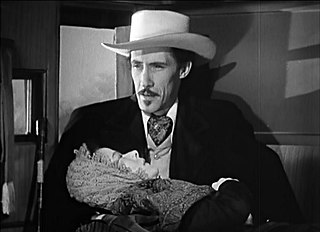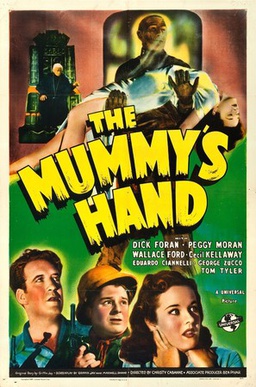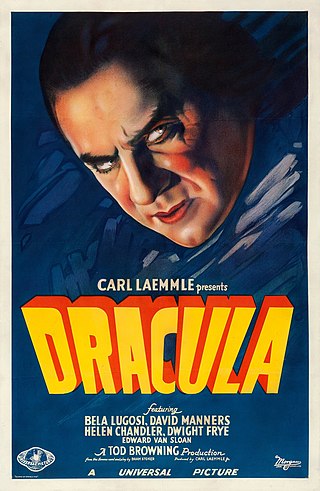
William Henry Pratt, known professionally as Boris Karloff and occasionally billed as Karloff the Uncanny, was an English actor. His portrayal of Frankenstein's monster in the horror film Frankenstein (1931) established him as a horror icon, and he reprised the role for the sequels Bride of Frankenstein (1935) and Son of Frankenstein (1939). He also appeared as Imhotep in The Mummy (1932), and voiced the Grinch in, as well as narrating, the animated television special of Dr. Seuss' How the Grinch Stole Christmas! (1966), which won him a Grammy Award.

Abbott and Costello Meet Frankenstein is a 1948 American horror comedy film directed by Charles Barton. The film features Count Dracula who has become partners with Dr. Sandra Mornay, as Dracula requires a "simple, pliable" brain to reactivate Frankenstein's monster. Dracula discovers that the "ideal" brain belongs to Wilbur Grey who is wooed by Mornay to the operating table, despite the warnings of Lawrence Talbot.

Creighton Tull Chaney, known by his stage name Lon Chaney Jr., was an American actor known for playing Larry Talbot in the film The Wolf Man (1941) and its various crossovers, Count Alucard in Son of Dracula, Frankenstein's monster in The Ghost of Frankenstein (1942), the Mummy in three pictures, and various other roles in many Universal horror films, including six films in their 1940s Inner Sanctum series, making him a horror icon. He also portrayed Lennie Small in Of Mice and Men (1939) and supporting parts in dozens of mainstream movies, including High Noon (1952), The Defiant Ones (1958), and numerous Westerns, musicals, comedies and dramas.

Terence Fisher was a British film director best known for his work for Hammer Films.

Son of Frankenstein is a 1939 American horror film directed by Rowland V. Lee and starring Basil Rathbone, Boris Karloff and Bela Lugosi. The film is the third in Universal Pictures' Frankenstein series and is the follow-up to the 1935 film Bride of Frankenstein. Son of Frankenstein stars Rathbone as Baron Wolf von Frankenstein who, with his wife Elsa and son Peter, returns to his late father's estate. Near the castle lives Ygor, a crazed blacksmith whose neck was broken in an unsuccessful hanging attempt. Among the castle's remains, Frankenstein discovers the remains of the Monster and decides to try to save his family name by resurrecting the creature to prove his father was correct. He finds, however, the Monster only responds to Ygor's commands.

This is a list of John Carradine's hundreds of theatrical films. Television appearances and television movies are not included.

Frankenstein Meets the Wolf Man is a 1943 American horror film directed by Roy William Neill and starring Lon Chaney Jr. as the Wolf Man and Bela Lugosi as Frankenstein's monster. This was the first of a series of later called "monster rallies" combining characters from several film series. This film's script written by Curt Siodmak follows The Ghost of Frankenstein and The Wolf Man. The film involves Larry Talbot who is brought back to life. Seeking a way to return to his death to escape his werewolf curse, he meets with gypsy Maleva who advises him that the only way to stay dead is to confer with Dr. Frankenstein. The doctor is long dead but his equipment is in working condition, leading Talbot to seek the help of scientist Dr. Mannering and Frankenstein descendant Baroness Elsa Frankenstein. Talbot then attempts to have his life sucked from his body and transferred into Frankenstein's monster.

Son of Dracula is a 1943 American horror film directed by Robert Siodmak with a screenplay based on an original story by his brother Curt Siodmak. The film stars Lon Chaney Jr., Louise Allbritton, Robert Paige, Evelyn Ankers, and Frank Craven. The film is set in the United States, where Count Alucard has just taken up residence. Katherine Caldwell (Allbritton), a student of the occult, becomes fascinated by Alucard and eventually marries him. Katherine begins to look and act strangely, leading her former romantic partner Frank Stanley (Paige) to suspect that something has happened to her. He gets help from Dr. Brewster (Craven) and psychologist Laszlo who come to the conclusion that Alucard is a vampire.

House of Frankenstein is a 1944 American horror film starring Boris Karloff, Lon Chaney Jr. and John Carradine. Based on a story by Curt Siodmak, it was directed by Erle C. Kenton and produced by Universal Pictures. The film is about Dr. Gustav Niemann, who escapes from prison and promises to create a new body for his assistant Daniel. Over the course of the film, they encounter Count Dracula, Larry Talbot, the Wolf Man, and Frankenstein's Monster.

House of Dracula is a 1945 American horror film released and distributed by Universal Pictures. Directed by Erle C. Kenton, the film features several Universal Horror properties meeting as they had done in the 1944 film House of Frankenstein. The film is set at the castle home of Dr. Franz Edelmann, who is visited first by Count Dracula and later by Larry Talbot, the Wolf Man, who are trying to cure their vampirism and lycanthropy, respectively. Talbot is eventually cured, which leads him to discover the body of Frankenstein's monster in a cave below the base of the castle. Edelemann takes the monster's body back to his laboratory but finds Count Dracula has awakened and by attacking his assistants, he captures Edelmann and forces a reverse blood transfusion, which gives Edelmann a split personality and makes him a killer.

The Mummy's Hand is a 1940 American horror film directed by Christy Cabanne and produced by Ben Pivar for Universal Studios. Shot in black-and-white, the film is about the ancient Egyptian mummy of Kharis, who is kept alive with a brew of tana leaves by The High Priest and his successor Andoheb. Meanwhile, archeologists Steve Banning and Babe Jenson persuade magician Solvani to finance an expedition in search of the tomb of Princess Ananka. They are joined by Solvani's daughter Marta, and followed by Andoheb who is also the professor of Egyptology at the Cairo Museum. Kharis is ordered to kill off expedition members Dr. Petrie and Ali, while Andoheb becomes attracted to Marta who he plans to kidnap and make immortal.

Universal Classic Monsters is a home video line based on a series of horror films primarily produced by Universal Pictures from the 1930s to the 1950s. Although not initially conceived as a franchise, the enduring popularity and legacy of the films and the characters featured in them has led the studio to market them under the collective brand name of Universal Studios Monsters. It includes the three most famous monsters Dracula, Frankenstein, and The Wolf Man.
George Waggner was an American actor, director, producer and writer. He is best known for producing and directing the 1941 film The Wolf Man. For some unknown reason, Waggner sometimes configured his name in mostly lowercase letters but with his surname's two Gs capitalized ("waGGner"), including in the credits of some of the productions he directed.

Coming Soon is a 1982 American direct-to-video documentary film directed by John Landis for Universal Pictures. Landis used trailers of old Universal horror and thriller films to create his own contribution to his favorite film genres. The film is narrated by Jamie Lee Curtis.

Frankenstein is a film series of horror films from Universal Pictures based on the play version by Peggy Webling and the 1818 novel Frankenstein; or, The Modern Prometheus by Mary Shelley. The series follow the story of a monster created by Henry Frankenstein who is made from body parts of corpses and brought back to life. The rest of the series generally follows the monster continuously being revived and eventually focuses on a series of cross overs with other Universal horror film characters such as The Wolf Man. The series consists of the following films: Frankenstein (1931), Bride of Frankenstein (1935), Son of Frankenstein (1939), The Ghost of Frankenstein (1942), Frankenstein Meets the Wolf Man (1943), House of Frankenstein (1944), House of Dracula (1945) and Abbott and Costello Meet Frankenstein (1948).

Dracula is a film series of horror films from Universal Pictures based on the 1897 novel Dracula by Bram Stoker and its 1927 play adaptation. The series is a loose collection of films, with historians stating that the films all reference characters, events or at least passing knowledge of the 1931 English-language production of Dracula, with historians noting that Dracula's Daughter and Son of Dracula are more closely related to the 1931 film while the character of Dracula would make smaller appearances in later films such as House of Frankenstein and House of Dracula. After Dracula's Daughter, the character of Dracula and other vampires in the series became more Americanized, starting with the release of Son of Dracula, and the later House of films. The character of Dracula appears in all the films outside of Dracula's Daughter, where he is portrayed by Bela Lugosi, Lon Chaney Jr., and John Carradine in the House of films.

The Invisible Man is a film series by Universal Pictures. The series consists of The Invisible Man, The Invisible Man Returns, The Invisible Woman, Invisible Agent, The Invisible Man's Revenge and Abbott and Costello Meet the Invisible Man. The film series borrows elements from H. G. Wells's novel The Invisible Man, but it focuses primarily on the idea of a serum that causes someone to go invisible and its side-effects.
Vera West was an American fashion designer and film costume designer. From 1928 to 1947, she was the chief costume designer for Universal Pictures.
George Robinson (1890-1958) was an American cinematographer from Los Angeles.

The history of horror films was described by author Siegbert Solomon Prawer as difficult to read as a linear historical path, with the genre changing throughout the decades, based on the state of cinema, audience tastes and contemporary world events.
















